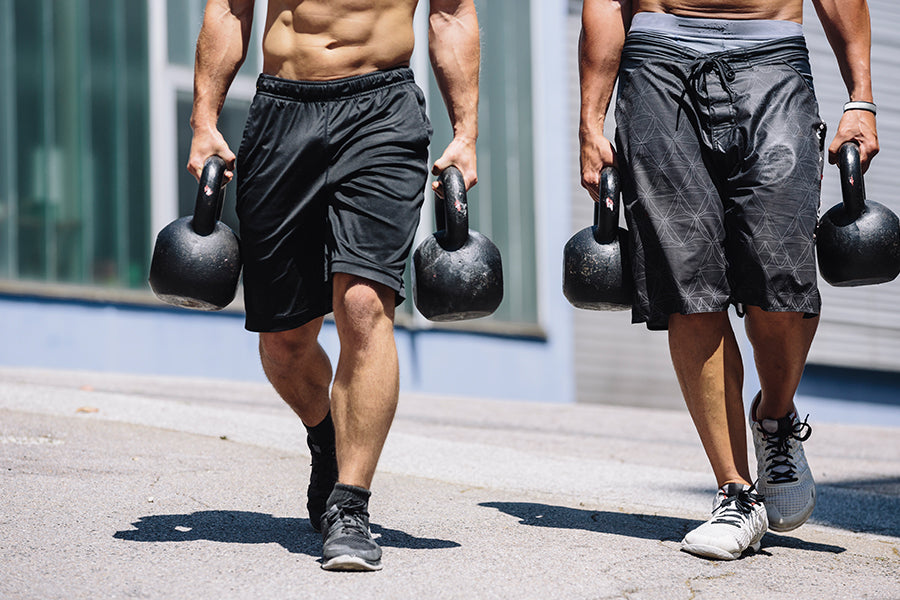You don't need to look any further than the farmer's carry if you want to increase your performance, core stability, and overall strength to the next level. Although the movement is straightforward, it is efficient and is frequently underestimated for its power.
Let's get down to the nitty-gritty of getting the most out of the farmer's carry workout so you can improve your athletic performance.
What is Farmer’s Carry
A loaded carry workout called the farmer's carry, also known as the farmer's carry, is performed by holding free weights at your sides while walking. Another name for this exercise is the farmer's walk.
The farmer's carry engages several muscle groups throughout the upper body as well as the lower body. When performed correctly, the farmer's walk can assist in the development of core strength, the burning of calories, and the elevation of heart rate.
This exercise is often performed with a pair of dumbbells; however, some variations employ other heavyweights such as kettlebells, trap bars, or barbells with farmer's walk handles attached.
Following are the detailed steps that need to be performed to perform farmer's carry with perfect form:
- Position yourself so that the handles of the dumbbells are in line with the center of your feet. Stand in between two dumbbells.
- Your feet should be shoulder-width apart, and your back should be completely straight. This will help you maintain a tall posture.
- You should bend your knees ever-so-slightly. Your shoulders should be directly above your hips, and you should maintain a neutral position with your head and neck. Maintain a tucked chin during the entire exercise.
- Maintain a steady position by distributing your weight evenly and getting a good grasp on the ground with both feet.
- Maintain a long arm position with your arms by your sides and bend your elbows slightly. Prepare your shoulders, hips, and core muscles by tensing them.
- Before lowering yourself toward the dumbbells, take a few deep breaths in and out.
- To lower your body toward the dumbbells, you first need to hinge your hips back and bend your knees, hips, and ankles.
- Take hold of the dumbbells using a neutral grip with your hands pointing toward you. To stand properly, ensure that your hips, knees, and ankles are aligned.
- To activate your lats, rotate your shoulders so that they face outward. Keep your upper back pulled in and keep a firm grasp on the dumbbells. This position should serve as the starting point for all repetitions.
- Begin the workout by moving ahead straight as you take a few steps. Take typical strides while ensuring that your posture is aligned correctly and that you have a firm grasp. Your steps should follow the typical heel-to-toe pattern used by most people.
- After thirty to sixty seconds of walking, you should stop and lower the dumbbells to the ground by extending your hips backward and bending your knees, hips, and ankles.
Related Article: How to Perform the Farmer’s Walk — Benefits, Form & the Muscles Worked
Muscles Worked
Performing the farmer's carry requires using every muscle in your body. The arms, shoulders, upper back, and abdominals are put through their paces throughout this exercise. It also puts a lot of strain on your lower body muscles, like your glutes, quads, hamstrings, and calves. This is a very cost-effective workout.
Glutes
The glutes are key players in hip stability and strength during walking, jumping, sprinting, and strength training. The farmer’s carry helps strengthen the gluteus medius — a muscle that helps stabilize the torso and pelvis alongside the gluteus maximus — and can help alleviate lower back pain and make everyday movements, such as standing, walking, and climbing the stairs, that much easier.
Adductors
The adductors are a group of muscles located inside the thighs that play a crucial role in stabilizing the pelvis and keeping it balanced during the gait cycle. During the walking portion of the farmer's carry, the adductors are put to good use (essentially the entire movement).
Hamstrings
The hamstrings extend from the pelvic region to the back of the thigh. The hip flexors, the knee extensors, and the thigh muscles play essential roles in the gait cycle. Even though the farmer's carry does not require a lot of hip flexion and extension, the hamstrings are actively engaged during the entire movement.
Related Article: 10 Essential Hamstring Exercises to Build Muscle and Boost Your Athleticism
Calves
In terms of its functional role, the calf muscle contributes to the bending of the knee and is a crucial muscle in stabilizing the knee during loaded carries such as the farmer's carry.
Quadriceps
The quadriceps, which are made up of the rectus femoris, vastus lateralis, vastus medialis, and vastus intermedius which are crucial in extending the knee and flexing the hip. The quadriceps play a dual role in the farmer's carry, first helping to maintain hip stability and then extending the knee during the carrying phase.
Trapezius
The trapezius is a big muscle in your upper and middle back, sometimes called a trap. This massive muscle is the primary source of stress in the upper back while carrying a heavy object in one's hands; hence it plays a crucial function in stabilizing the scapula (shoulder blades).
During a farmer's carry, the three heads of the traps work hard to keep the back tight and stable.
Latissimus Dorsi
The latissimus dorsi, more colloquially known as the "lats," are a group of muscles most well-known for their ability to bring the arm to and around the back of the body.
The farmer's carry calls for a slightly different function from the lats, which involves supporting the pelvis and engaging with the abdominal muscles in breathing, shoulder placement, and spine protection.
Core
When performing loaded motions like the farmer's carry, the core muscles (most notably the abdominals, erector spinae, quadratus lumborum, and others) assist in stabilizing the spine and pelvis.
The farmer's carry satisfies the requirements for an advanced core-based functional exercise, as it calls for a combination of rapid acceleration, rapid deceleration, and rapid stabilization.
Arms & Shoulders
Farmers' carries demand a lot of grip strength from the arms and shoulders, particularly the forearms. Shoulder stability is a less well-known role for the biceps and triceps. Each of the biceps and triceps has a lengthy head that attaches to the scapula, and these attachments help to displace the humerus.
The shoulder joint also takes a severe beating when required to raise and hold heavy weights. The deltoids and other surrounding muscles support the shoulder's ball-and-socket joint, more accurately referred to as a ball-and-saucer joint due to its shallower depth compared to the hip joint.
Farmer’s Carry Variations
You can do many different things to change up your farmer's carry, but most involve lifting a new object in a different posture. Here are four different versions of the farmer's carry that we enjoy.
Suitcase Carry

The suitcase carry is a multiplanar exercise that requires a coordinated effort across your core and hip musculature to maintain posture while executing the activity. This exercise is also known as the unilateral farmer's carry.
Despite its apparent ease, the bag carry places a significant demand on the trunk muscles' ability to co-contract in synchrony with one another and maintain equilibrium.
- With your feet shoulder-width apart and your arms at your sides, grab a kettlebell with your non-dominant hand.
- Ensure your posture is erect and engage your core muscles to bring your shoulder blades down and back.
- Carrying the kettlebell in your hand, step forward and start walking. Take tiny, deliberate steps and pay attention to maintaining a strong core and straight posture rather than propelling yourself forward.
- For a predetermined amount of time or steps, keep performing this activity. Set the weight down once you are done on that side.
- Repeat while using the other hand to pick up the kettlebell.
Towel Grip Farmer’s Carry

Put a cloth through the handle of a kettlebell and hold one or two bells in your hands to strengthen your grip (s). You'll develop thicker forearms as a result of having to squeeze much harder to maintain your grip on the towels.
- Loop a towel around a dumbbell or a kettlebell handle, ensuring it's securely placed.
- Perform farmer’s carry as usual while holding the weights from the towel.
- Slowly place them down once done.
Benefits of Farmer's Carry
Following are the benefits of Farmer’s carry.
Full Body Workout
Your whole body will take damage from the farmer's carry. The biceps, triceps, forearms, shoulders, upper back, trapezius, quadriceps, hamstrings, calves, lower back, obliques, transverse abdominis, and rectus abdominis all get stronger as a result of this exercise.
When you apply a significant amount of weight, you may also experience a burning sensation in your chest.
Increases Grip Strength
This exercise is excellent for developing grip strength in the hands and wrists since it requires you to handle weights for an extended period. Grip strength is necessary to do daily chores like lifting and carrying grocery bags successfully.
Builds Core Strength
The farmer's carry is another excellent move for building core strength. Because of this, you may experience less back pain, improved balance, and enhanced flexion, extension, and trunk rotation.
Common Farmer’s Carry Mistake
We all know how easy it is to pick something up, carry it someplace else, and set it down again. You should still expect to make some missteps while lifting. Ensure you're not making any of these standard mistakes when learning to perform a farmer's carry.
Going Too Light
Going too easy may not seem like a problem, and there are certainly benefits to a more casual approach. But if you're not regularly pushing yourself with sufficiently heavy weight, you can leave many gains on the table. If you are training heavily enough, you should be approaching failure after your distance or time objective for this motion.
Stride Length
You should probably take quick, short steps if you're just starting. And if you're into competition and heavy lifting, you might continue doing that. However, you may not be a complete novice but an intermediate or advanced athlete looking to improve your strength and stamina using this technique. If that's the case, consider shortening your stride to something appropriate for your skill level.
It's best to avoid taking steps of a standard size. However, as skill and experience levels rise, the best strategy for maximizing output and performance is to keep stride length relatively constant while raising stride rate.
Unhealthy Posture of the Upper Back
Some tired weightlifters may try to look strong by shrugging their shoulders. While you want your shoulders to be front and down during a shrug, you want them to be back and down during a farmer's carry to get the most out of your upper back.
That way, you can learn to maintain a tight, engaged pack in your lats throughout the entire exercise. As a bonus, this will keep you from leaning on your sides while lifting.
Related Article: 12 Mistakes That May Be Hindering Your Progress At the Gym
The Bottom Line
The farmer's carry is an exercise that involves picking up a heavy object from the ground and walking with it. It's an excellent way to strengthen your legs, buttocks, hips, shoulders, upper back, traps, lats, abdominals, forearms, and hands. Increased muscle strength and power, as well as improved cardiovascular health, are two tangible benefits. The farmer's walk is a great cardio exercise that works well with strength training.
If you have a history of injuries, it is recommended that you consult with your doctor before incorporating the farmer's walk into your training routine.








